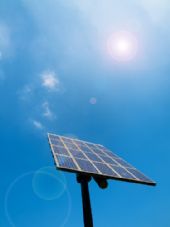Building solar voltaic cells from nanowires instead of standard metal conductors can increase the amount of energy that can be captured by a factor of 15, according to a new study by scientists from the Nano-Science Centre in Denmark.
The study, published in the peer-reviewed journal Nature Photonics, found that nanowires have unique light absorption properties, meaning the limit of how much energy can be harnessed from the sun’s rays is vastly higher than previous believed.
When the sun’s rays are drawn into a nanowire, which stands on a substrate, at a given wavelength, the sunlight is concentrated up to 15 times.
The research focused on improving the quality of the nanowire crystals, which is a cylindrical structure with a diameter 1/10,000th that of a human hair.
The typical efficiency limit for photovoltaic cells, known as the "Shockley-Queisser Limit" has been the benchmark for solar cell efficiency.
The Denmark researchers, however, found that nanowires naturally concentrate the sun’s rays into a very small area in nanowire crystal and because the diameter of a crystal is smaller than the wavelength of the light coming from the sun, it can cause resonances in the intensity of light in and around nanowires. Those resonances then offer a higher conversion efficiency for the sun’s energy, according to Niels Bohr Institute researcher Peter Krogstrup.
The nanowires are predicted to have great potential in the development not only of solar cells, but also of future quantum computers and other electronic products.
"It’s exciting as a researcher to move the theoretical limits, as we know. It will have a major impact on the development of solar cells, exploitation of nanowire solar rays and perhaps the extraction of energy at [the] international level," Peter Krogstrup a Niels Bohr Institute researcher, said in a statement.
"However, it will take some years before production of solar cells consisting of nanowires becomes a reality," he said.
IDG News Service








Subscribers 0
Fans 0
Followers 0
Followers